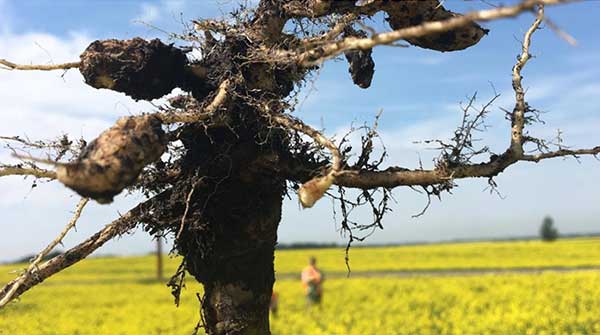Having multiple management strategies to curb clubroot is going to be more important than ever
New strains of clubroot, a disease that can kill canola crops, continue to emerge in Western Canadian fields, according to a recent study by University of Alberta researchers.
A sampling of more than 250 fields in Alberta, Saskatchewan and Manitoba conducted in 2019 and 2020 identified 25 unique clubroot pathotypes, including seven new strains – six of them capable of infecting canola plants bred to resist the disease.
|
|
|
|
“The findings really underscore how quickly pathotype shifts are occurring and how quickly we are finding new pathotypes. And it is likely we will continue to find new ones,” says study lead Keisha Hollman, a PhD candidate in plant science in the Faculty of Agricultural, Life & Environmental Sciences.
|
|
| Related Stories |
| Lime shows promise for controlling clubroot in canola crops
|
| New canola-killing clubroot strains found in Western Canada
|
| $1.25-million project tackles clubroot resistance in canola
|
Clubroot is caused by a parasite that infests field soil with resting spores that can survive up to 20 years. Canola and related plants such as cabbage grown in the infested soil develop tumours on the roots, which block water and nutrient uptake, causing stunted growth, yellowing, wilting and, in worst cases, death of the plant.
Listed under Alberta’s Agricultural Pests Act, clubroot can cause a loss of 60 to 90 percent canola crop yield in one of Canada’s most valuable cash crops.
The disease is continuing to evolve, according to the study.
In 2019 alone, 23 pathotypes were documented in prairie canola fields, showing “the most diversity we have ever found in a single year,” Hollman says.
Along with that discovery, the research revealed that more resistance-breaking strains of clubroot are becoming predominant, meaning they are the most commonly found. Of the five most common pathotypes identified in Alberta as of 2020, three overcome genetic resistance.
The finding brings the total number of known clubroot pathotypes to 43, some of which were identified in an earlier U of A study that documented 36 unique strains on the prairies by 2018.
Though most of the pathotypes are found in only a handful of fields, their increasing diversity and continued emergence means relying less heavily on genetic resistance, Hollman suggests.
“Seed breeders can only keep up with so much change and diversity,” she says, noting that it can take up to a decade to develop a clubroot-resistant plant.
Canola producers must continue to manage the risk through “integrated management strategies” that help take the pressure off genetic resistance alone, Hollman says.
Measures include sanitizing farm and other field equipment between fields, and rotating crops. A 2019 U of A study, for example, showed that after a two-year break from growing canola, the number of clubroot spores decreased by about 90 percent in field soil.
Soil treatments such as liming also provide potential options for managing the disease, Hollman notes.
Promising research could also help, including U of A exploration of molecular marker identification to speed up pathotype testing.
“That will help give a better idea of clubroot diversity and spread in Alberta,” she says.
And with canola breeders developing new varieties with “second-generation” resistance to clubroot, having multiple management strategies is going to be more important than ever, she adds.
“That genetic stewardship could help prolong the longevity of new cultivars.”
The study will help inform continued clubroot management efforts in Western Canada and, along with similar U of A research, also contribute to a new resistance labelling initiative for commercial canola varieties, says co-author Stephen Strelkov, a U of A plant pathologist who supervised Hollman’s research.
The collaborative effort, led by a cross-industry expert group chaired by the Canola Council of Canada, aims to create a standardized product label system that helps canola growers easily determine and compare the resistance available in particular varieties.
Multiple labels currently being used in the marketplace provide grower information in different ways, which can cause confusion when choosing a canola seed that will be effective against a particular pathotype in the field, he says, noting that not all varieties are resistant to all of the pathotypes.
“The recommendations for which pathotypes to start with in the initiative are based on our work, and will ultimately help farmers make informed decisions when managing clubroot resistance.”
| By Bev Betkowski
This article was submitted by the University of Alberta’s Folio online magazine, a Troy Media Editorial Content Provider Partner.
The opinions expressed by our columnists and contributors are theirs alone and do not inherently or expressly reflect the views of our publication.
© Troy Media
Troy Media is an editorial content provider to media outlets and its own hosted community news outlets across Canada.



